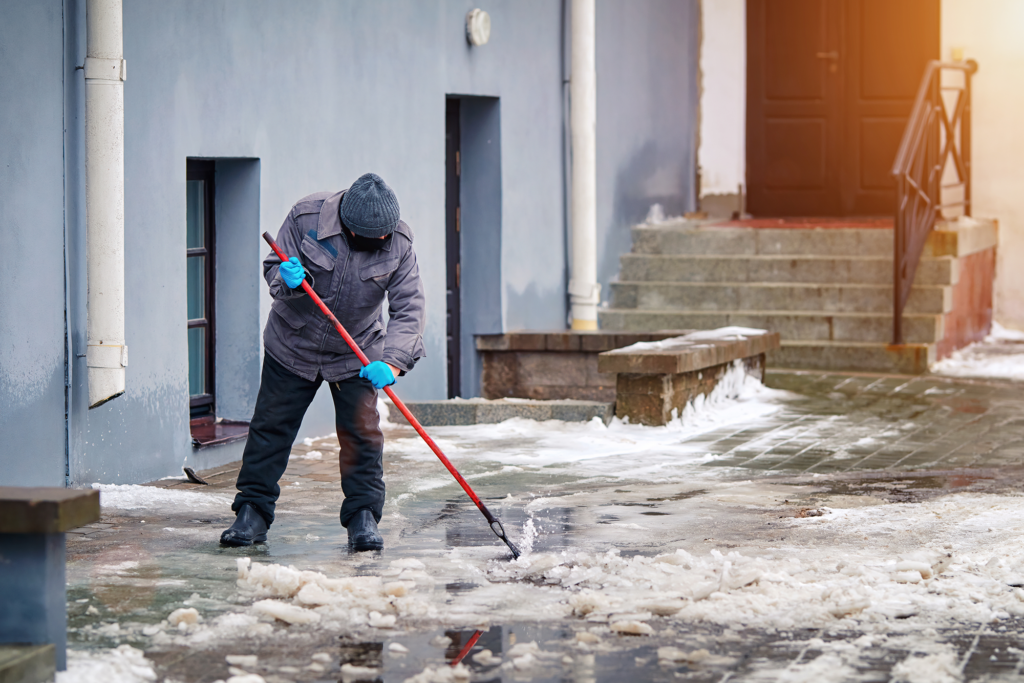De-icing Outdoor Walking Surfaces in Winter

Keeping outdoor walking surfaces—such as parking lots and sidewalks—clear of ice in the winter is a crucial practice at many workplaces. Not only does ice removal offer aesthetic benefits, it can also help keep you, your co-workers and the general public (e.g., customers or passersby) protected from the risk of slips and trips on the job site.
With this in mind, here’s how you can play your part in promoting effective and safe de-icing measures at the workplace this winter.
Ice Removal Best Practices
Use the right mixture. The most effective method for de-icing an outdoor walking surface is by applying a chemical mixture throughout the area to either melt any ice that already exists or prevent ice from forming altogether. This mixture typically includes rock salt (sodium chloride), magnesium chloride pellets or calcium chloride pellets. That being said, make sure to use the correct mixture for the conditions at hand.
Rock salt is most effective in temperatures above 5 degrees Fahrenheit.
Calcium chloride pellets and magnesium chloride pellets are most effective in temperatures below 5 degrees Fahrenheit.
Regardless of which mixture you use, consider incorporating sand into your mixture before applying it to the surface. Doing so will help limit the amount of mixture that you use and allow for extra traction when applied to the surface—thus minimizing the risk of slips and trips taking place.
Watch the weather. Keep an eye on the weather forecast to determine when you need to apply the de-icing mixture to outdoor walking surfaces. This mixture should be applied when temperatures are below freezing or if conditions such as snow, hail or sleet are possible.
Apply the mixture correctly. Make sure you apply the de-icing mixture in thin, even layers across outdoor walking surfaces. Try to apply one layer before conditions occur, one or more layers while these conditions are taking place and a final layer after conditions have passed. Keep in mind that if there is snow on a surface, it will need to be shoveled first before you can apply the de-icing mixture. Simplify the de-icing process by shoveling snow after every few inches of accumulation rather than all at once.
Protect your hands. Keep your hands properly protected when applying the de-icing mixture by wearing thick mittens and using a scoop to distribute the mixture.
Eliminate excess materials. When temperatures warm up and the de-icing mixture is no longer necessary, be sure to properly dispose of any remaining mixture left across outdoor walking surfaces. Leaving excess mixture on a surface when it isn’t needed could end up creating, rather than removing, slip and trip hazards, as well as potentially damaging the surface itself.
Winter Weather Precautions
While de-icing outdoor walking surfaces at the workplace, it’s vital to protect yourself from winter weather risks. Be sure to implement the following safety precautions during ice removal:
Always check the weather before working outdoors to properly prepare yourself. Try to limit your time outside if weather conditions are extremely cold, wet or windy.
Ensure you dress appropriately for the task at hand. Wear several loose layers of clothing, a warm hat that fully covers your head and ears, mittens (rather than gloves) and thick socks that will keep your feet dry. Also, utilize shoes with plenty of traction and insulation in order to keep your feet warm and reduce your risk of slipping on icy or snowy surfaces.
Take a few minutes to stretch before you begin working outdoors to better prepare your body and limit the potential for sprain or strain injuries.
Be sure to eat healthy foods that are rich in carbohydrates and protein prior to working in the cold to help fuel your body. Stay hydrated by drinking plenty of water before, during and after your shift.
Make sure you know the initial signs of health complications such as overexertion, fatigue, frostbite and hypothermia. If you start developing symptoms for these issues, stop working and inform your supervisor.
Fore more ways to protect your business, contact INSURICA today.
This is not intended to be exhaustive nor should any discussion or opinions be construed as legal advice. Readers should contact legal counsel or an insurance professional for appropriate advice. ©2023 Zywave, Inc. All rights reserved







